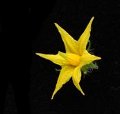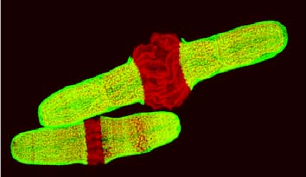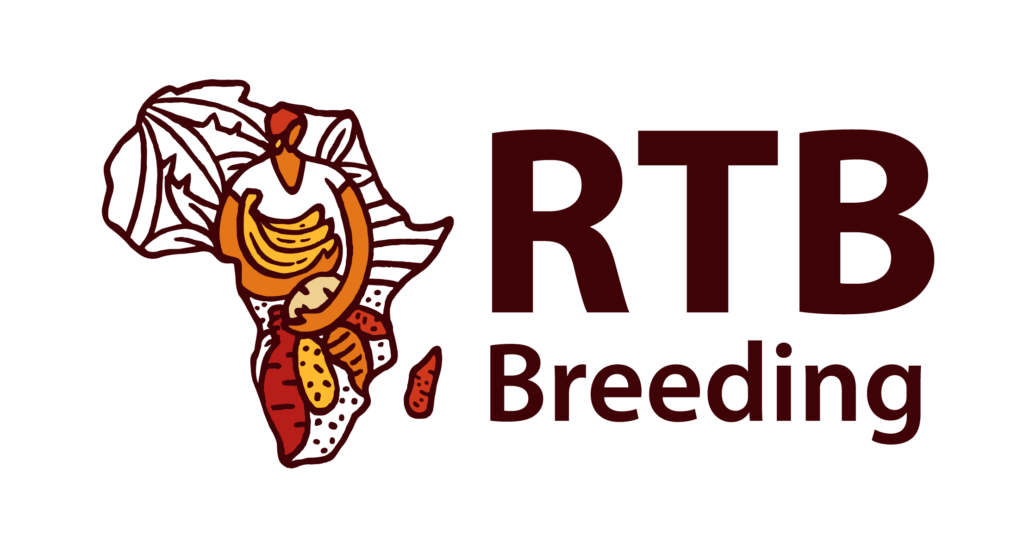
Spin-off Projects and Collaborations
Interspecific Reproductive Barriers in Tomato (IRBT)

Solanum lycopersicum flower
This is an NSF Plant Genome program funded collaborative scientific endeavor to identify and understand the biological processes underlying species isolation within the Tomato family. We are using proteomic tools to study the molecular barriers between tomato species, with particular focus on secreted proteins as these are believed to be critical in establishing such barriers. We have been characterizing the proteomes of pollen, styles and pollinated styles from both Solanum lycopersicum, S. habrochaites and S. pennellii.
The Evolutionary Origins of the Plant Cell Wall and Associated Secretome

Cells of Penium margaritaceum, a member of the Charophycean green alga, following treatment with a microtubule inhibitor. Pectin components of the wall are shown in green. Microscopic imaging and cover design by David Domozych.
One of the most important phases of plant evolution occurred approximately 460-480 million years ago when photosynthetic organisms developed the capacity to colonize land. This transition to harsh terrestrial conditions would have required the ability to resist new abiotic stresses, including desiccation and UV radiation, as well as the development of mechanisms to promote progeny dispersal. It is likely that polysaccharide and cuticular cell walls were essential for the transition to a terrestrial environment and yet the evolutionary origins of their biosynthesis are not well understood. In collaboration with Dr. William Willats (University of Copenhagen), Dr. David Domozych (Skidmore College). Dr. Jeffrey Doyle and Dr. Iben Sørensen (Cornell University), we are addressing the hypothesis that the origins of plant cell walls occurred during divergence within the Charophycean green algae (CGA), which represent the closest living relatives to land plants (embryophytes). Characterization of the secretomes of divergent members of the CGA will likely provide insights into the mechanisms that are currently used by embryophytes for primary, secondary and cuticular cell wall formation and restructuring.
| Publications |

- Alos, E., Roca, M., Iglesias, D.J., Minguez-Mosquera, M.I., Damasceno, C.M.B., Thannhauser, T.W., Rose, J.K.C., Talon, M. and Cercos (2008) An evaluation of the basis and consequences of a stay-green mutation in the navel negra (nan) citrus mutant using transcriptomic and proteomic profiling and metabolite analysis. Plant Physiology 147: 1300-1315.
- Lopez-Casado, G., Urbanowicz, B.R., Damasceno C.M.B. and Rose J.K.C. (2008) Plant glycosyl hydrolases and biofuels: a natural marriage. Current Opinion in Plant Biology 11: 329-337.
- Urbanowicz, B.R. and Rose J.K.C. (2008) Sustainable biofuels: a daunting challenge for plant scientists. Chemistry Today 26: 23-25.
- The International Brachypodium Initiative (2010) Genome sequence analysis of the model grass Brachypodium distachyon: insights into grass genome evolution. Nature 462: 763-768.
- Sorensen, I., Pettolino, F. A., Bacic, A., Ralph, J., Lu, F., O'Neill, M., Fei, Z., Rose, J.K.C., Domozych, D. and Willats, W.G.T. (2011) The charophycean green algae provide insights into the early origins of plant cell walls. The Plant Journal 68: 201-211.
- Acuna, J.R., Padilla, B.E., Florez C.P., Rubio, J.D., Herrera, J.C., Benivades, P., Lee, S.-J., Yeats, T.H., Egan, A.N., Doyle, J.J. and Rose, J.K.C. (2012) Adaptive horizontal transfer of a bacterial gene to an invasive insect pest of coffee. Proceedings of the National Academy of Sciences USA 109: 4197-4202.
- Sorensen, I., Rose, J.K.C., Doyle, J.J., Domozych, D.S. and Willats, W.G.T. (2012) The charophycean green algae as model systems to study plant cell walls and other evolutionary adaptations that gave rise to land plants. Plant Signaling and Behavior 7: 1-3.
- Lopez-Casado, G., Covey, P.A., Bedinger, P.A., Mueller, L.A., Zhang, S., Fei, Z., Giovannoni, J.J. and Rose, J.K.C. (2012) Enabling proteomic studies with RNA-Seq: the proteome of tomato pollen as a test case. Proteomics 12: 761-774.





